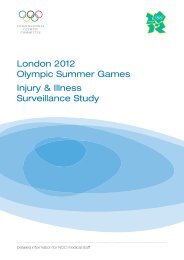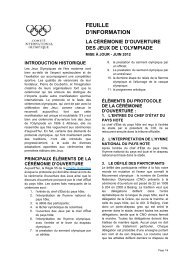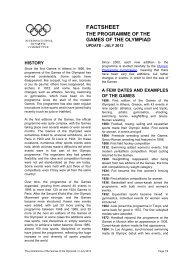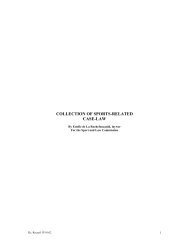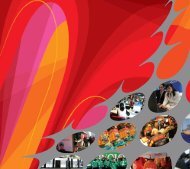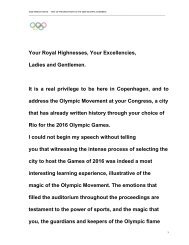MANUAL SPORT ENVIRONMENT
MANUAL SPORT ENVIRONMENT
MANUAL SPORT ENVIRONMENT
You also want an ePaper? Increase the reach of your titles
YUMPU automatically turns print PDFs into web optimized ePapers that Google loves.
plants located in y our region<br />
• implement sorting at source (sufficient and separate rubbish bins)<br />
• dispatch the materials to recycling markets<br />
• separate hazardous w aste from domes tic w aste<br />
• treat all w aste properly<br />
• implement a waste management programme if necessary<br />
2.5.4 Large-scale Sports Events: Specific Recommendations<br />
41<br />
Large-scale sports events attract high numbers of people and nec ess itate the<br />
handling of large quantities of goods. This c oncentration of people in time and place<br />
represents a potential danger for the env ironment. Some measures have to be taken<br />
in order to limit the impact.<br />
A) Sports facilities<br />
• use provis ional installations for the facilities not needed in the long term;<br />
encourage improv ement of exis ting fac ilities<br />
• use prov isional and module equipment w hich is easy to transform and reuse<br />
• implement multiple-use facilities<br />
• guar antee to restor e pr ovisional facilities and enc ourage the restoration of<br />
damaged s ites<br />
B) Sports equipm ent<br />
• the organizing committee must define environmental requirements for spons ors<br />
and suppliers , s uch as env ironmentally friendly process es and produc ts,<br />
collaboration on w aste management systems, etc.<br />
• ensure that the organizations partic ipating in the event are certified in accordance<br />
w ith ISO standards<br />
C) Tr ansportation and air quality<br />
• implement transport strategies to ensure the efficient movement of people<br />
(athletes, coaches, journalists, officials and spectators)<br />
• establish a transportation c oncept promoting trans port on foot, by bicyc le and<br />
public trans portation<br />
• establish a global air quality plan for the region<br />
- monitor emiss ions<br />
- enc ourage major air polluters, including public utilities to take permanent steps to<br />
reduce their emissions prior to the event<br />
- establis h energy management strategies<br />
- encourage trans portation fleet operators to take steps to reduce emissions<br />
- w ork w ith municipal officials to reduce traffic<br />
D) Energy<br />
• establish an energy management programme for the region taking into account<br />
the transportation system and s ports facilities






